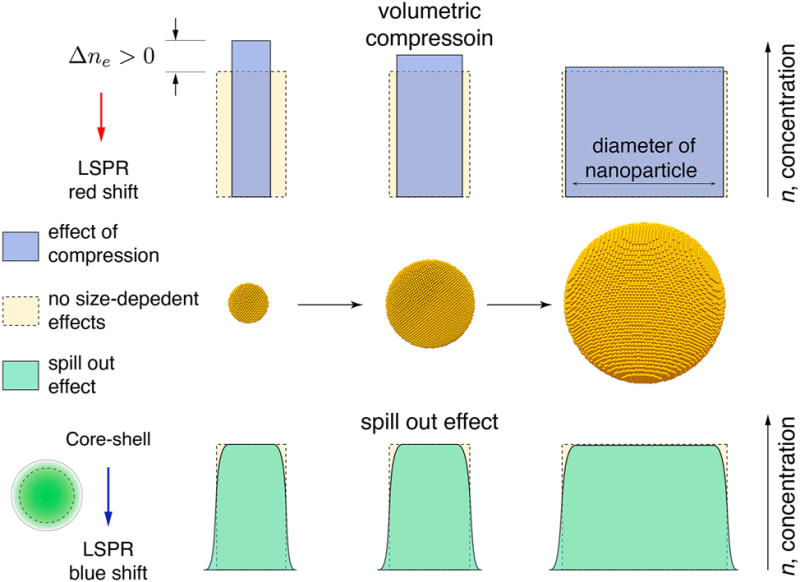Researchers from ITMO University and the Krasnoyarsk Science Center of the Siberian Branch of the Russian Academy of Sciences (SB RAS) have advanced the theory of light absorption in ultrafine plasmonic nanoparticles. This breakthrough enhances our understanding of nanomaterials' behavior, improves techniques for targeting and destroying cancer cells, and opens up avenues to new areas of research, including quantum plasmonics. The findings were published in Nanophotonics.

3D visualization of gold nanoparticles. Credit: katerynakon / photogenica.ru
Noble metal nanoparticles, such as silver and gold, possess the ability to absorb and scatter light, with maximum absorption occurring at a specific wavelength known as plasmon resonance. This intriguing phenomenon is not only present in scientific applications but can also be observed in art; for instance, the vibrant colors of medieval stained glass are the result of incorporating tiny metallic particles into the glass. It enables the labeling and visualization of specific cells for monitoring purposes, facilitates the conversion of light into heat to effectively destroy cancer cells during photothermal therapy, and enhances the precision of chemical composition analysis in drugs or DNA during disease diagnosis using Raman spectroscopy.
The behavior of plasmon resonance is influenced by both the shape and, crucially, the size of nanoparticles. In the size range of 10-30 nm, nanomaterials exhibit wavelength-independent light absorption. However, within the smaller size range of 3-10 nm, plasmon resonance begins to exhibit unusual anomalies, shifting significantly toward the shortwave (blue) end of the spectrum. This phenomenon has puzzled physicists, as it cannot be adequately explained by existing models. Such anomalies highlight limitations in current theoretical frameworks and indicate a need for a deeper understanding of nanoscale processes.

The accompanying schematic illustrates two key processes occurring in ultrafine metal nanoparticles: size-dependent volumetric compression and spill-out effects. These phenomena significantly influence the distribution of electron density within the particles and determine the spectral position of the maximal localized surface plasmon resonance. Image courtesy of the researchers
A team of scientists from ITMO University, the Krasnoyarsk Science Center of SB RAS, Siberian Federal University, and Uppsala University (Sweden) has conducted a comprehensive study on the relationship between nanoparticle size and the spectral position of their plasmon resonance. Utilizing the data obtained, the researchers developed an intricate theoretical model that elucidates how the resonant properties of nanoparticles change as their size decreases from 10 nm to 3 nm. This model enables accurate predictions of the optical properties of gold and silver nanoparticles across a broad size range, facilitating the rapid and precise creation of new materials with desired characteristics.
“As nanoparticles decrease in size, the behavior of their electrons undergoes significant changes. The conduction electrons are displaced from the ultrafine metal particles, causing a portion of them to concentrate near the surface. Simultaneously, a region with reduced conduction electron density forms within the particle’s surface layer, creating a unique shell with distinct properties. Notably, the thickness of this shell remains unaffected by the particle’s size – a phenomenon known as the spill-out effect. As a result of these effects, silver nanoparticles smaller than 10 nm demonstrate enhanced absorption of light in the shorter (blue) wavelength range of the spectrum. In contrast, larger particles tend to absorb more effectively in the longer (red) wavelengths,” explained Andrey Bogdanov, one of the paper's authors and an associate professor at ITMO’s Faculty of Physics.

Andrey Bogdanov. Photo by Dmitry Grigoryev / ITMO.NEWS
Plasmonic nanoparticles are already being used in biomedicine, for example, for cellular visualization, detection of molecules within living cells, bioimaging using fluorescence enhanced by plasmons, and optical spectroscopy. The researchers' discovery will enhance our understanding of the behavior of these ultrafine nanomaterials, leading to more effective applications and improved predictions of their effects.
“Ultrafine plasmonic nanoparticles, measuring less than 10 nm, possess a remarkable ability to enhance the electromagnetic field exclusively near their surface at nanoscale distances. This unique characteristic renders them invaluable for medical sensors capable of detecting a wide range of targets, including molecules, viruses, and proteins. In addition, plasmonic particles play a critical role in innovative techniques for photothermal treatment of prostate cancer, particularly using gold nanoshells. Consequently, it is essential to explore the biological applications of these ultrafine nanoparticles, which can penetrate cells through ion channels in their membranes. This capability paves the way for new possibilities in the localized destruction of cancer cells through laser hyperthermia,” added Sergey Karpov, DSc, a leading researcher at the Kirensky Institute of Physics of the Krasnoyarsk Science Center of SB RAS.
Beyond their medical applications, a deeper understanding of the properties of ultrafine particles opens new avenues for scientific exploration, particularly in the realm of "new physics." This includes fields such as quantum plasmonics and the development of innovative low-power devices. Such technologies have the potential to perform logical operations using ultrasensitive optical elements that leverage the unique characteristics of ultrafine plasmonic nanoparticles.
This research project is supported by the federal program Priority 2030.
Alena Mamaeva
Journalist
Catherine Zavodova
Translator
